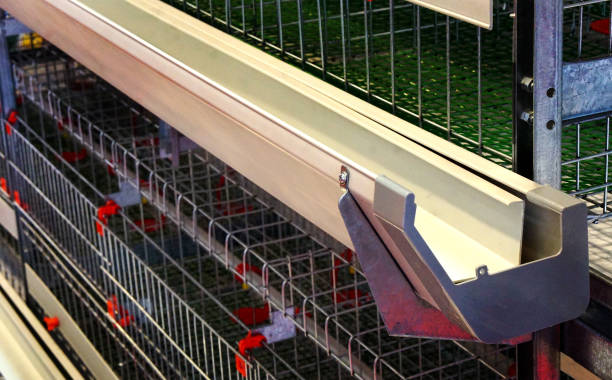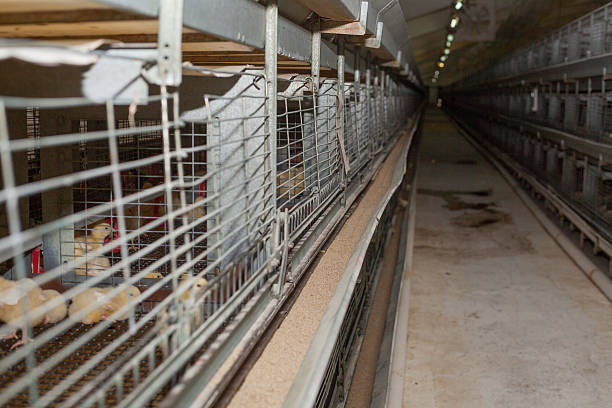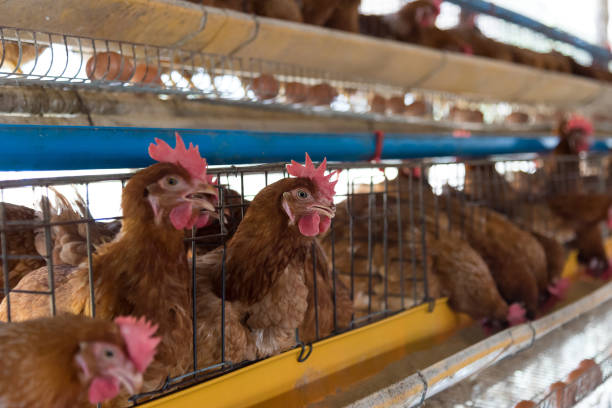Decoding Layer Chicken Cage System Costs: A Guide for African Poultry Farmers
Decoding Layer Chicken Cage System Costs: A Guide for African Poultry Farmers
For African poultry farmers looking to scale up their egg production, understanding the costs associated with layer chicken cage systems is crucial. A well-informed investment can lead to a thriving and profitable poultry business, while neglecting the financial aspect can quickly lead to disappointment. This guide breaks down the various cost factors involved in setting up a layer chicken cage system, offering practical advice and insights specifically tailored for the African context.
Why Choose Layer Chicken Cages?
Before delving into costs, it’s important to understand the benefits that make layer chicken cages a popular choice among poultry farmers:
Increased Efficiency: Cages significantly increase the stocking density, allowing you to house more chickens in the same space compared to free-range or deep-litter systems. This translates to higher egg production per square meter.
Improved Hygiene and Disease Control: Cages help separate the chickens from their waste, reducing the risk of disease outbreaks and improving overall hygiene. This leads to healthier chickens and lower mortality rates.
Easier Management: Feeding, watering, and egg collection become more streamlined with cage systems. This reduces labor costs and makes it easier to monitor the health and productivity of your flock.
Reduced Egg Breakage: Eggs roll out of the cages and are collected separately, minimizing breakage and ensuring a higher percentage of marketable eggs.
Better Feed Conversion Ratio: Caged chickens tend to have a better feed conversion ratio because they expend less energy on movement. This means you get more eggs per unit of feed consumed.
Key Cost Components of a Layer Chicken Cage System

The total cost of a layer chicken cage system can be broken down into several key components:
The Cage System Itself: This is the most significant investment. Cage systems come in different configurations and materials, which directly affect the price.
Types of Cage Systems:
A-Frame Cages: These are the most common and affordable type, suitable for small to medium-sized farms. They’re easy to install and maintain.
H-Frame Cages: These are more robust and typically used in larger commercial operations. They offer better space utilization and automation potential.
Flat-Deck Cages: These are a simpler design, often used for smaller-scale operations or starter farms.
Materials:
Galvanized Steel: The most common material due to its durability and resistance to rust. The thickness of the galvanization affects the lifespan of the cage.
Stainless Steel: A more expensive option, but offers superior corrosion resistance, making it ideal for humid environments.
Factors Affecting Cage Costs:
Capacity: The number of birds the cage system can house directly impacts the price.
Automation Level: Systems with automatic feeding, watering, and egg collection will be more expensive but can significantly reduce labor costs.
Manufacturer: Different manufacturers offer varying levels of quality and pricing. Researching reputable suppliers is crucial.
Transportation Costs: Shipping costs can be a significant factor, especially for farmers in remote areas.
Installation Costs: Some suppliers offer installation services, which can add to the initial cost but ensure proper setup.
Chicken House Construction or Modification: You’ll need a suitable structure to house the cage system. This could involve building a new chicken house or modifying an existing one.
New Construction Costs: The cost of building a chicken house depends on factors such as:
Size: The size of the house must accommodate the cage system and allow for sufficient workspace.
Materials: The choice of building materials (bricks, concrete, wood, or metal) significantly affects the cost.
Labor: Hiring skilled labor for construction can be a substantial expense.
Location: Building costs can vary depending on the location and availability of materials.
Modification Costs: If you’re modifying an existing structure, costs will depend on the extent of the renovations required. This might involve:
Reinforcing the Floor: To support the weight of the cage system and the chickens.
Improving Ventilation: To ensure adequate airflow and prevent the buildup of ammonia.
Installing Proper Lighting: To optimize egg production.
Creating a Biosecurity Zone: To prevent the introduction of diseases.
Feeding System: The feeding system is a critical component of a layer chicken cage system.
Manual Feeding: Involves distributing feed by hand. This is a labor-intensive option suitable for small-scale operations. The cost is relatively low, primarily consisting of buckets and troughs.
Semi-Automatic Feeding: Uses a mechanical system to distribute feed along the cages. This is a good compromise between manual and fully automated systems, reducing labor costs while remaining relatively affordable.
Automatic Feeding: A fully automated system that delivers feed to the cages at pre-set intervals. This option is more expensive but significantly reduces labor costs and ensures consistent feeding.
Watering System: Providing a consistent supply of clean water is essential for egg production.
Nipple Drinking System: This is the most common type of watering system for layer chicken cages. It consists of nipples that the chickens peck to release water. Nipple systems are hygienic, reduce water wastage, and are relatively easy to maintain.
Trough Watering System: Involves a trough running along the cages, providing water for the chickens. This system is less hygienic than nipple systems and can lead to water wastage.
Egg Collection System: The method of collecting eggs can impact labor costs and egg breakage rates.
Manual Egg Collection: Involves collecting eggs by hand. This is a labor-intensive option suitable for small-scale operations.
Automatic Egg Collection: Uses a conveyor belt system to collect eggs from the cages and transport them to a central collection point. This option is more expensive but significantly reduces labor costs and minimizes egg breakage.
Manure Removal System: Efficient manure removal is crucial for maintaining hygiene and preventing the buildup of ammonia.
Manual Manure Removal: Involves removing manure by hand using shovels and wheelbarrows. This is a labor-intensive option suitable for small-scale operations.
Automatic Manure Removal: Uses a scraper system to remove manure from under the cages. This option is more expensive but significantly reduces labor costs and improves hygiene. Some systems also incorporate manure drying, which can reduce odor and make the manure easier to handle and sell as fertilizer.
Other Essential Equipment: Besides the core components, you’ll also need other essential equipment:
Lighting System: Proper lighting is crucial for stimulating egg production. LED lights are energy-efficient and provide the optimal spectrum for laying hens.
Ventilation System: Adequate ventilation is essential for maintaining air quality and preventing the buildup of ammonia. Fans and ventilation systems help to remove stale air and bring in fresh air.
Heating and Cooling Systems: Depending on the climate, you may need heating or cooling systems to maintain a comfortable temperature for the chickens.
Biosecurity Equipment: Foot baths, disinfectant sprays, and protective clothing are essential for preventing the spread of diseases.
Operational Costs: These are ongoing expenses that you’ll incur throughout the life of the poultry farm.
Feed Costs: Feed is the largest operational cost. The type and quality of feed will directly impact egg production and the health of the chickens.
Water Costs: Water is essential for egg production and the health of the chickens.

Electricity Costs: Electricity is needed to power lighting, ventilation, and other equipment.
Labor Costs: The cost of hiring workers to manage the farm.
Vaccination and Medication Costs: Vaccines and medications are essential for preventing and treating diseases.
Mortality Rate: Although not a direct cost, a higher mortality rate can drastically impact profitability.
Maintenance Costs: Repairs and maintenance of the cage system and other equipment.
Estimating the Total Cost
Estimating the total cost of a layer chicken cage system requires careful planning and consideration of all the factors mentioned above. To obtain an accurate estimate, it’s recommended to:
Get Quotes from Multiple Suppliers: Compare prices and quality from different manufacturers.
Develop a Detailed Business Plan: Include all anticipated costs and revenues.
Consider Local Conditions: Factor in the specific challenges and opportunities in your region.
Consult with Experienced Poultry Farmers: Learn from their experiences and get valuable insights.
Factor in Contingency Costs: Set aside a buffer for unexpected expenses.
Tips for Reducing Costs
While quality and reliability are paramount, there are strategies to minimize initial investment:
Consider Used Equipment: Purchasing used cage systems in good condition can significantly reduce costs.
Start Small and Expand Gradually: Begin with a smaller operation and scale up as your business grows.
Optimize Housing: Efficiently design the chicken house to minimize construction costs.
Negotiate with Suppliers: Don’t be afraid to negotiate prices and payment terms with suppliers.
Explore Financing Options: Seek loans or grants from government agencies or financial institutions.
Train Staff Effectively: Competent staff can minimize waste and maximize egg production.
Making the Right Investment
Investing in a layer chicken cage system is a significant decision. By carefully analyzing the costs and potential benefits, African poultry farmers can make informed choices that lead to a successful and profitable poultry business. Remember to prioritize quality, reliability, and sustainability to ensure long-term success. Don’t be afraid to ask questions, do your research, and seek expert advice. A well-planned and executed layer chicken cage system can transform your poultry farm and contribute to food security in Africa.





